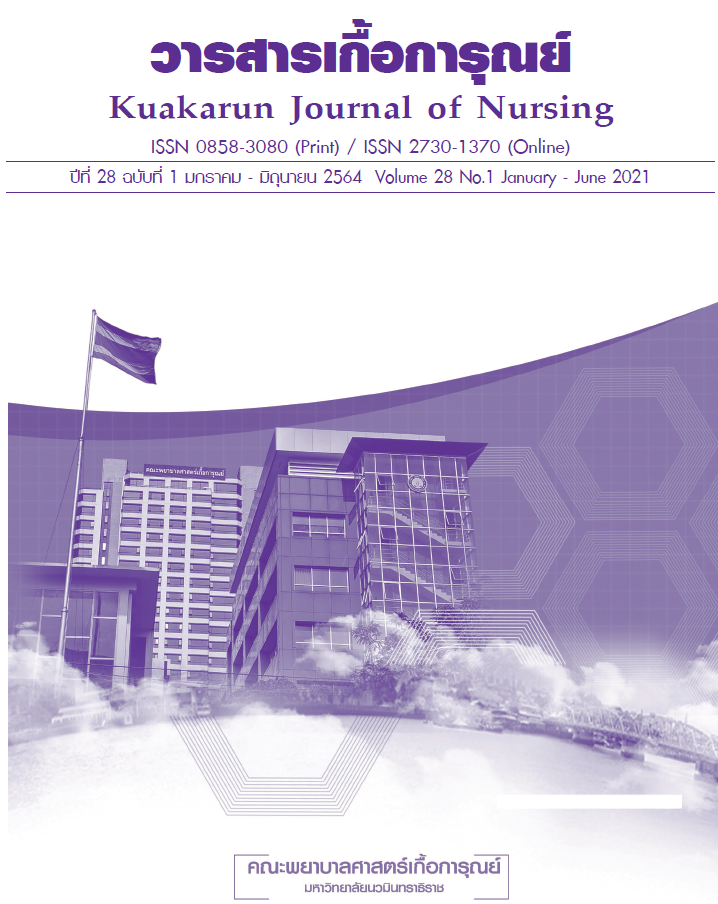การพยาบาลผู้ป่วยผ่าตัดเอ็นไขว้หน้าข้อเข่า
คำสำคัญ:
การบาดเจ็บของเอ็นไขว้หน้า, การพยาบาลผู้ป่วยผ่าตัดเอ็นไขว้หน้าข้อเข่าบทคัดย่อ
การบาดเจ็บของเอ็นไขว้หน้าข้อเข่าส่วนใหญ่พบในวัยผู้ใหญ่ สาเหตุเกิดจากข้อเข่าได้รับอุบัติเหตุจากการกระแทก อาการและอาการแสดง ได้แก่ ปวด มีเสียงดังในเข่า รู้สึกเหมือนเข่าหลุด เสียสมดุลในการทรงตัว ทำให้เป็นอุปสรรคในการใช้ชีวิตประจำวัน การตรวจวินิจฉัย ได้แก่ การตรวจน้ำในข้อเข่า การตรวจความมั่นคงของข้อเข่า การเอกซเรย์ การตรวจคลื่นแม่เหล็กไฟฟ้า และการส่องกล้อง เป็นต้น การรักษาระยะแรกเน้นการรักษาแบบประคับประคอง หากการบาดเจ็บรุนแรงจนถึงระดับที่ทำให้เอ็นไขว้หน้าฉีกขาดผู้ป่วยจะได้รับการผ่าตัดเพื่อสร้างหรือซ่อมแซมเอ็นไขว้หน้า การพยาบาลผู้ป่วยเมื่อได้รับการผ่าตัดซ่อมแซมเอ็นไขว้ข้อเข่าที่สำคัญในช่วงก่อนผ่าตัด คือ การให้ข้อมูลและการฝึกฟื้นฟูสภาพหลังผ่าตัด เช่น การส่งเสริมการหายใจและการไออย่างมีประสิทธิภาพ และการกระดกปลายเท้า ส่วนช่วงหลัง 24 ชั่วโมง เน้นการป้องกันภาวะแทรกซ้อนหลังผ่าตัดจากการได้รับการระงับความรู้สึกเฉพาะที่ อุณหภูมิกายต่ำ ภาวะเลือดออก ภาวะลิ่มเลือดอุดตันในปอด อาการปวด ชาขาข้างผ่าตัด และหลังผ่าตัด 24 - 72 ชั่วโมง เน้นการป้องกันการติดเชื้อ อาการปวด การเกิดข้อยึดติด และฝึกความมั่นคงของเข่า ซึ่งผู้ป่วยควรได้รับการส่งเสริมการฟื้นฟูสภาพตั้งแต่ช่วงเตรียมความพร้อมก่อนผ่าตัดจนถึงจำหน่ายออกจากโรงพยาบาล เพื่อให้ผู้ป่วยสามารถกลับไปใช้งานเอ็นข้อเข่าได้เป็นปกติหรือใกล้เคียงปกติ ปลอดภัยจากการหกล้ม และมีคุณภาพชีวิตที่ดีหลังการผ่าตัด
เอกสารอ้างอิง
Sanders TL, Maradit Kremers H, Bryan AJ, Dahm DL, Levy BA, Stuart MJ, et al. Incidence of anterior cruciate ligament tears and reconstruction: a 21-year population-based study. American Journal of Sports Medicine 2016;44(6):1502-7.
Grindem H, Engebretsen L, Axe M, Snyder-Mackler L, Risberg MA. Activity and functional readiness, not age, are the critical factors for second anterior cruciate ligament injury - the Delaware-Oslo ACL cohort study. British Journal of Sports Medicine 2020;54(18):1099-102.
Cheecharern S, Lohpongpaiboon C. Outcomes of anterior cruciate ligament reconstruction in Rajavithi hospital. Journal of the Medical Association of Thailand 2018;101(Suppl 2):S9-18.
Thomas N, Carmichael J. Failure in ACL reconstruction: etiology, treatment, and results. In: Bonnin M, editor. The knee joint. Paris: Springer; 2012. p. 343-53.
Macaulay AA, Perfetti DC, Levine WN. Anterior cruciate ligament graft choices. Sports Health 2012;4(1):63-8.
The American Academy of Orthopaedic Surgeons (AAOS). Anterior cruciate ligament (ACL) injuries [Internet]. 2014 [cited 2020 Jan 10]. Available from: https://orthoinfo.aaos.org/en/diseases--conditions/anterior-cruciate-ligament-acl-injuries
Tamsat A. Nursing care for patients with knee ligament injuries. In: Areeue S, editor. Orthopaedic nursing: from evidence to clinical nursing practice. Bangkok: Ideol Digital Print; 2021. p. 299-323. (in Thai)
DiFelice GS, van der List JP. Clinical outcomes of arthroscopic primary repair of proximal anterior cruciate ligament tears are maintained at mid-term follow-up. Arthroscopy: The Journal of Arthroscopic & Related Surgery 2018;34(4):1085-93.
Krause M, Freudenthaler F, Frosch KH, Achtnich A, Petersen W, Akoto R. Operative versus conservative treatment of anterior cruciate ligament rupture. Deutsches Arzteblatt International 2018;115(51-52):855-62.
Evans J, Nielson Jl. Anterior cruciate ligament knee injuries: treasure Island [Internet]. 2020 [cited 2020 Jan 10]. Available from: https://www.ncbi.nlm.nih.gov/books/NBK499848/
Melick van N, Cingel van REH, Brooijmans F, Neeter C, Tienen van T, Hullegie W, et al. Evidence-based clinical practice update: practice guidelines for anterior cruciate ligament rehabilitation based on a systematic review and multidisciplinary consensus. British Journal of Sports Medicine 2016;50(24):1506-15.
Widner M, Dunleavy M, Lynch S. Outcomes following ACL reconstruction based on graft type: are all grafts equivalent?. Current Reviews in Musculoskeletal Medicine 2019;12(4):460-5.
Levy DM, Frank RM, Bach Jr BR, Verma NN. Perioperative pain and swelling control in anterior cruciate ligament reconstruction. Operative Techniques in Sports Medicine 2016;24(1):21-8.
Gokeler A, Neuhaus D, Benjaminse A, Grooms DR, Baumeister J. Principles of motor learning to support neuroplasticity after ACL injury: implications for optimizing performance and reducing risk of second ACL injury. Sports Medicine 2019;49(6):853-65.
Koaban S, Alatassi R, Ahmed B, Alogayyel N. Bilateral pulmonary embolism after arthroscopic anterior cruciate ligament reconstruction: a case report. International Journal of Surgery Case Reports 2018;49:64-6.
Wang B, Zhong JL, Xu XH, Shang J, Lin N, Lu HD. Incidence and risk factors of joint stiffness after anterior cruciate ligament reconstruction. Journal of Orthopaedic Surgery and Research 2020;15(1):175.
Alm L, Krause M, Frosch KH, Akoto R. Preoperative medial knee instability is an underestimated risk factor for failure of revision ACL reconstruction. Knee Surgery, Sports Traumatology, Arthroscopy 2020;28(8):2458-67.
Thai Orthopaedic Nurses’ Society. Clinical nursing practice guideline for patients with hip fracture undergoing hip replacement and clinical nursing practice guideline for patients with hip fracture undergoing total knee replacement. Bangkok: N P Press; 2018. (in Thai)
Hajian P, Haddadzadegan N, Nikouseresht M, Seif-Rabiee MA, Yavarikia A. Comparison of analgesic effect of femoral nerve block and continuous intravenous infusion pump, after anterior cruciate ligament reconstruction in first postoperative day. Anaesthesia, Pain & Intensive Care 2019;18(3):250-5.
Saiborisut J, Billateh P, Chaibandit C. The development of clinical nursing practice guidelines for prevention and management hypothermia in patients who undergo operation at a private hospital. Thai Journal of Anesthesiology 2019;45(3):104-10. (in Thai)















